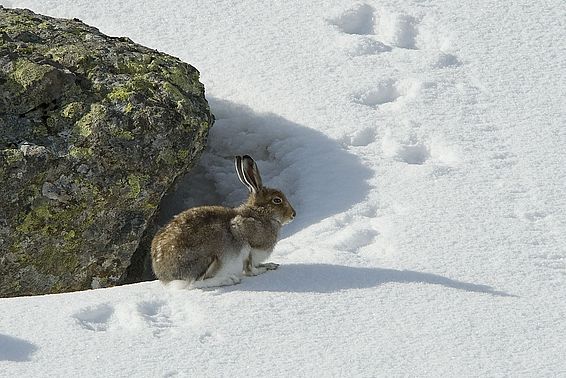13.03.2018 | News WSL
A warming climate will shrink and fragment mountain hare habitat in the Swiss Alps. Populations are likely to decline as a result, concludes an international study led by the Swiss Federal Institute for Forest, Snow and Landscape Research (WSL) and the University of Bern.
Specialised species like the mountain hare, adapted to life at high altitudes, are particularly affected by climate change. If temperatures become too warm for the mountain hare, it only has limited options to move to cooler, higher elevations. In fact, the area of suitable mountain hare habitat in Switzerland is expected to shrink by an average of one third by the year 2100. This is the conclusion of a study by the WSL, the University of Bern and the University of Natural Resources and Applied Life Sciences, Vienna (BOKU).
And that habitat will not only diminish in size, but also become more fragmented. As a result, mountain hare populations will be less well interconnected, which may lead to genetic impoverishment. According to the study published in the journal Global Change Biology, overall numbers of mountain hares are expected to decline. At the same time, the study pinpoints the mountain hare's most important future habitats, crucial for interconnecting individual populations and protecting the species.
Mountain hares suffering from heat stress
The research team investigated the impact of climate change on the species' distribution in the Swiss Alps, based on 1,046 mountain hare observations recorded between 1990 and 2013. In addition, it modelled the location and extent of suitable current and future habitat, following various scenarios envisaged by the International Panel on Climate Change (IPCC). The suitability of a habitat for mountain hares depends on factors such as food availability, protection from predators, heat and cold, and human disturbance.
It turned out that above all rising temperatures during the hare's breeding season influence the habitat available to the species. Cold-adapted species are less adept than heat-loving species at regulating their body temperature during hot summers. They have to move to cooler environments, which are necessarily limited by narrowing mountains and craggy rock faces.
The researchers' model calculations predicted a habitat loss for Swiss mountain hares of 26% in a medium warming scenario and 45% in a strong warming scenario. However, there turned out to be substantial regional differences, with the greatest habitat loss to be expected in the southern and northern Alpine foothills. By contrast, less loss was anticipated in the Central Alps, though there, too, habitat for mountain hares was expected to decline significantly.
National monitoring recommended
«Habitat loss and increasing habitat fragmentation will increasingly imperil the species», says lead author and WSL researcher Maik Rehnus. «Our study identified key areas for interconnecting mountain hare populations in Switzerland. They represent the backbone for the mountain hare's future distribution», adds the WSL's Kurt Bollmann, who led the study together with Veronika Braunisch from the University of Bern. The authors recommend setting up a national mountain hare monitoring scheme in these areas as well as on the periphery of the species' current range. «That would help to fill gaps in our knowledge about regional differences in population development and the endangerment of the species», maintains Rehnus.
Links and documents ¶
Original publication:
Rehnus, et al: Alpine glacial relict species losing out to climate change: the case of the fragmented mountain hare population (Lepus timidus) in the Alps. Glob Change Biol. 2018;1-18. DOI: 10.1111/gcb.14087
Contact ¶
Copyright ¶
WSL and SLF provide image and sound material free of charge for use in press releases in connection with this media release. The use of this material in image, sound and/or video databases and the sale of the material by third parties is not permitted.

